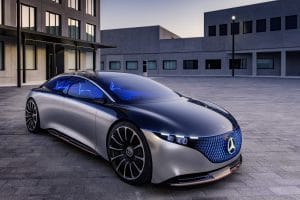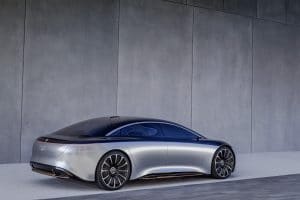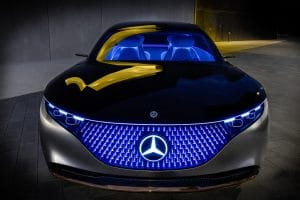
The Mercedes-Benz Vision EQS provides an outlook on a concept for a fully-electric vehicle in the luxury class.
Daimler AG, the parent of the Smart and Mercedes-Benz brands, plans to spend nearly $25 billion on batteries and the plants to build them during the next decade, and that doesn’t even factor in the billions more it will invest in developing an array of all-electric and plug-in hybrid models.
It’s already shown off a number of pure battery-electric concepts and production models, such as the EQB and EQC, with the production version of its EQV van debuting at this week’s Frankfurt Motor Show. It is sharing the stage with another all-electric model that, though just a show car – for now – hints at what could be coming in the form of a battery-powered alternative to the flagship S-Class.
Dubbed the Mercedes-Benz Vision EQS, the German automaker wants to prove that a full-size luxury automobile also can be environmentally sustainable – and not just by switching from gas or diesel power to an electric drivetrain. The sedan concept makes extensive use of recycled materials, including what it calls “ocean waste” plastics.
(Mercedes-Benz Taking Orders for New EQC Electric Crossover)
Visually, the Vision EQS adopts what Mercedes has dubbed a “one bow” design language, taking the coupe-like shape of its current S-Class to the next level. While long, low and wide, the concept accommodates the new opportunities afforded by the skateboard-like platform that houses its battery pack, motors and other drivetrain components. Freeing up space normally devoted to the engine compartment allows for more space for passengers and cargo.
Like a number of key competitors, the underlying architecture will reappear underneath other products in the future.

The Vision EQS adopts what Mercedes has dubbed a “one bow” design language, taking the coupe-like shape of its current S-Class to the next level.
“With the Vision EQS technology platform, Mercedes-Benz is opting for a completely new, fully-variable battery-electric drive platform,” officials said ahead of the formal EQS debut in Frankfurt. “This is in many respects scalable and usable on a cross-model basis: thanks to the modern modular system, the wheelbase and track, as well as all other system components, and especially the battery, are variable and therefore suitable for a wide range of different vehicle concepts.
By relying on lightweight materials wherever possible, along with the concept’s aerodynamic design, its 100 kilowatt-hour battery pack should yield about 700 kilometers, or 435 miles of range, Mercedes said, using the European WLTP test cycle. (The U.S. EPA numbers would be about a quarter less, typically.)
Twin motors, one on each axle punch out a combined 469 horsepower and 560 pound-feet of torque. And, with that torque coming on almost instantaneously, Mercedes estimates the EQS would hit 60 mph in 4.5 seconds, with a top speed limited at more than 124 mph. The twin motors allow for a through-the-road all-wheel-drive system that can instantly shift power from front to rear.
(Mercedes Steps Up Mobility Options with EQC Edition 1886)
The battery pack is designed to accept the latest-generation high-speed chargers, at 800 volts and 350 kilowatts, getting 80% of its range back in less than 20 minutes.
Of course, it takes more than just range and power to make a traditional S-Class, and the EQS aims to shine both in terms of traditional luxury details and features that future buyers would be looking for.
From the outside, the concept uses light in ways that automakers traditionally turned to chrome for. Nearly 200 pinpoint LEDs surround the classic Mercedes tri-star logo up front, for one thing. Another 229 individually illuminated stars form the “lightbelt” at the rear.
Inside, the dashboard flows into the body of the EQS, with a touchscreen at the top of the floating center console. Additional screens are melded into the armrests for both driver and passenger. Together, the screens handle virtually all traditional vehicle functions. There are, of course, some more classic touches, such as “sophisticated speaker covers in rosé gold and the fragrance flask encased in a decorative holder like a jewel (which) showcase exquisite craftsmanship and round out the trendsetting interior.”
But Mercedes envisions the EQS as moving away from some classic luxury materials, replacing leather with an artificial material that has similar qualities. The material in the roof liner, it noted in a statement, is a “special project,” relying on a recycled materials including ocean waste plastic.
The EQS also features Level 3 driving capabilities to allow the motorist to relinquish many traditional driving duties, something that could make commuting, as well as long-distance travel, even less stressful.
(Mercedes-Benz EQV is a Near Production-Ready Electric Minivan)
While some elements of the EQS concept are classic show car fantasy, other elements are clearly do-able in the near-term, starting with the underlying platform. The automaker isn’t talking about specific plans for the future but, as with other recent concept models, few would be surprised if the Vision EQS gives a very direct hint as to where an all-electric flagship, a counterpoint to today’s S-Class, might drop into the line-up over the next few years.

